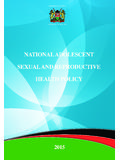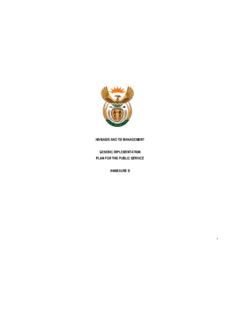Transcription of Creation of target specific funds (citizens ˇ …
1 39 Involvement of the Local Communities in development planning and budget prioritization is gaining recognition as one way of fostering rural development. Creation of target specific funds ( citizens empowerment fund , youth empowerment fund , land development fund ) is another strategy aimed at creating capital capacity for development in various enterprises which could result in reduced poverty and increased employment opportunities. Implementation of Decentralization policy (towards empowering the people) which will result in direct funding to districts and sub-district structures will foster development in the rural areas.
2 The launch of the Rural Finance Programme which is private sector driven will greatly contribute to rural development considering that while urban poverty reduced from 53 percent to 34 percent between 2004 and 2006, rural poverty actually increased from 78 percent to 80 percent during the same period . High un-employment among youths in towns and villages is one of the major challenges facing Government coupled with poor state of road infrastructure in rural areas and poor living conditions in urban areas.
3 The un-employed persons in rural areas migrate to cities and towns in search of employment, leading to poor living conditions in urban centres as most migrants find themselves in slums. The challenge of the Government is to meet the needs of the people in rural areas to curb rural-urban migration, while developing the capacity for sustainable urbanization as a long term measure. Creation of well planned small towns may be the best option to achieve balanced national development in a country like Zambia with vast land resources and a small population.
4 Lack of a long term integrated spatial development plan is one of the major constraints to national development. Currently spontaneous settlement dictates the shape and direction of cities/towns expansion in Zambia. CONCLUSION Zambia has made progress in the implementation of agenda 21, which is mainstreamed in the Fifth national Development Plan (FNDP) 2006-2010. Some of these achievements though not exhaustive, have been highlighted in this report. The achievements have translated into the strengthened macro economic performance.
5 This notwithstanding, Zambia has continued to face constraints and challenges in her pursuit for sustainable development. Poverty levels remained high mainly because of low investments in key sectors that employ majority of the inhabitants. Limited financial and human resources availability for under taking huge investment programmes such as infrastructure development have proved to be a major challenge. It is in this regard that Zambia is calling upon cooperating partners and the international community at large to provide support to its quest for sustainable development and advancement of the principles of Agenda 21.
6 38 Reducing the incidence of HIV and AIDS which has adversely affected girls education and has increased their vulnerability. Attitudes and beliefs obtaining in patriarchal systems of society that rate men as superior to women and they affect how men regard women especially when it comes to equal participation in decision making and economic empowerment. Slow action in translating policy pronouncements into implementable activities to ensure gender equality and empower women. Inability to engender the national budget and ensure that through the provincial, district and Gender Focal Point offices, District Gender Sub-Committees, women s needs which are different from those of men are taken into account.
7 Lack of comprehensive sensitisation on gender for all in the country with a view to changing attitudes. Cost sharing adversely affects the female completion rates of education at all levels of the school system. Where there are limited resources at household level, in providing financial support to education, preference is given to boys over girls. Girls are married off by their parents when they are still very young and at school- going age. Although Government has enunciated the pregnancy re-entry policy , not all females are able to return to school.
8 In traditional societies, there are generally poor attitudes to the education of females resulting in girls not going to school. The prevalence of HIV and AIDS has forced more females than males to drop out of school so that they can help in domestic chores which include bringing up orphans and caring for the sick. Micro Small and Medium Enterprises The sector has many constraints that include: inaccessible markets, lack of access to finance at affordable terms, lack of storage for inputs, poor transport facilities, lack of appropriate tools/machinery (poor technology), anti MSMEs regulatory barriers, lack of skilled labour, shortage of shop/rental space, unavailable utility services and technical problems.
9 In addition, MSMEs face existence of hazardous working environment, excess completion from imports and infrastructure weaknesses. It is natural that these constraints are minimized to bring the sector into prosperity through increased production throughout all its various activities, namely, manufacturing, processing, agricultural production, trading, textile, carpentry and wood based industry, metal fabrication and engineering, food, mining, leather and leather goods, and services. Thus, focusing on the sector s growth and development will have a multiplier impact on the national economy.
10 Resettlement 37government responsibility carried out by the Zambia national Tourist Board (ZNTB), with only a few stakeholders promoting their own products; There are inadequate resources for the industry s long-term development. Government funding of the tourism sector has been inadequate at a time when indigenous investors do not have adequate access to medium and long-term financing. Though the Tourism Development Credit Facility (TDCF) was established by the Government in 2003 to provide affordable credit to Zambians, the quantum of the fund (at K5 billion per year) coupled with large numbers of applicants made this funding source inadequate; There is lack of interest and limited participation among local communities.
















